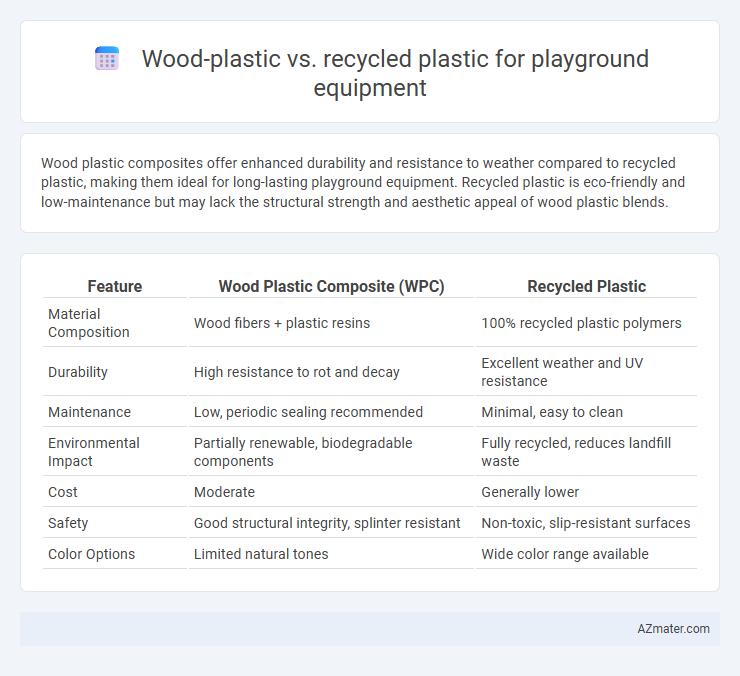Wood plastic composites offer enhanced durability and resistance to weather compared to recycled plastic, making them ideal for long-lasting playground equipment. Recycled plastic is eco-friendly and low-maintenance but may lack the structural strength and aesthetic appeal of wood plastic blends.
Table of Comparison
| Feature | Wood Plastic Composite (WPC) | Recycled Plastic |
|---|---|---|
| Material Composition | Wood fibers + plastic resins | 100% recycled plastic polymers |
| Durability | High resistance to rot and decay | Excellent weather and UV resistance |
| Maintenance | Low, periodic sealing recommended | Minimal, easy to clean |
| Environmental Impact | Partially renewable, biodegradable components | Fully recycled, reduces landfill waste |
| Cost | Moderate | Generally lower |
| Safety | Good structural integrity, splinter resistant | Non-toxic, slip-resistant surfaces |
| Color Options | Limited natural tones | Wide color range available |
Introduction: Choosing Materials for Playground Equipment
Wood plastic composites offer enhanced durability and weather resistance compared to traditional recycled plastics, making them ideal for playground equipment exposed to varying climates. Recycled plastics provide an eco-friendly solution by repurposing waste materials, contributing to sustainability and reducing environmental impact. Selecting the right material depends on balancing durability, maintenance requirements, environmental benefits, and safety standards for playground use.
What is Wood Plastic Composite?
Wood Plastic Composite (WPC) is a durable material made by blending wood fibers or sawdust with thermoplastics like polyethylene or polypropylene, resulting in enhanced strength and resistance to rot and insects. WPC offers a natural wood appearance combined with the low maintenance and weather resistance of plastic, making it ideal for playground equipment that requires safety and longevity. Compared to recycled plastic, WPC provides better rigidity and a more aesthetic finish, while still being eco-friendly by utilizing wood waste and recycled plastics in its production.
Understanding Recycled Plastic Materials
Recycled plastic materials for playground equipment, primarily derived from post-consumer and post-industrial plastics like HDPE and PVC, offer superior durability and resistance to weathering compared to traditional wood plastic composites. These materials reduce environmental impact by diverting plastic waste from landfills and require less maintenance, eliminating the need for painting, sealing, or staining. Their inherent resistance to splintering, fading, and cracking makes recycled plastics an ideal choice for safe and long-lasting playground structures.
Durability Comparison: Wood Plastic vs. Recycled Plastic
Wood plastic composite (WPC) playground equipment offers enhanced durability due to its resistance to rot, splintering, and insect damage compared to traditional wood, while recycled plastic provides superior resilience against moisture, fading, and cracking under extreme weather conditions. Recycled plastic playground structures typically require less maintenance and demonstrate longer lifespan in outdoor environments, making them more cost-effective over time. Both materials resist environmental degradation better than pure wood, but recycled plastic excels in moisture resistance and impact durability, crucial for playground safety and longevity.
Safety and Non-Toxicity in Playground Equipment
Wood plastic composite (WPC) playground equipment offers enhanced safety due to its reduced splinter risk and improved durability compared to traditional wood. Recycled plastic playground materials are non-toxic and resistant to mold, mildew, and chemicals, ensuring a safer environment for children with minimal maintenance. Both options prioritize safety and non-toxicity, but WPC combines the natural aesthetics of wood with the safety benefits of plastic, while recycled plastic emphasizes eco-friendly, chemical-free durability.
Environmental Impact and Sustainability
Wood plastic composites (WPC) for playground equipment combine natural wood fibers with plastic, offering enhanced durability and resistance to weathering while reducing the need for virgin plastic. Recycled plastic playground materials significantly decrease landfill waste and lower carbon emissions by repurposing post-consumer plastics, contributing to a circular economy. Both materials support sustainability, but recycled plastic provides a more substantial environmental benefit through waste reduction and resource conservation.
Maintenance and Longevity
Wood plastic composite (WPC) playground equipment requires less maintenance than traditional wood, resisting rot, splintering, and insect damage, which extends its lifespan significantly. Recycled plastic playground structures offer exceptional durability against weathering, fading, and cracking, leading to minimal upkeep and a lifespan often exceeding 25 years. Both materials provide enhanced longevity compared to untreated wood, but recycled plastic generally demands the least maintenance while sustaining robust structural integrity over time.
Cost Analysis: Initial and Long-Term Investment
Wood plastic composite (WPC) playground equipment generally requires a higher initial investment compared to recycled plastic due to manufacturing complexities and material costs. However, WPC offers superior durability and resistance to weathering, which can lower maintenance expenses and extend the lifespan, resulting in a more favorable long-term investment. Recycled plastic playground equipment has a lower upfront cost but may incur higher maintenance and replacement costs over time due to potential fading, cracking, or structural weaknesses.
Aesthetic Options and Design Flexibility
Wood plastic composites offer a natural wood-like appearance with a range of color and texture options that enhance playground aesthetics and blend seamlessly into outdoor environments. Recycled plastic provides more vibrant color choices and greater design flexibility due to its moldability, allowing intricate shapes and custom designs suitable for innovative playground structures. Both materials contribute to durable, weather-resistant playground equipment, but wood plastic emphasizes a traditional, organic look while recycled plastic supports bold, creative design possibilities.
Conclusion: Best Practices for Playground Material Selection
Selecting playground materials requires balancing durability, safety, and environmental impact; wood plastic composites offer enhanced strength and weather resistance compared to recycled plastics, reducing maintenance needs. Recycled plastics provide excellent eco-friendly benefits by diverting waste but may lack the structural robustness of wood plastic composites. Prioritizing materials that meet ASTM safety standards and sustainability certifications ensures optimal performance and longer lifespan for playground equipment.

Infographic: Wood plastic vs Recycled plastic for Playground equipment
 azmater.com
azmater.com